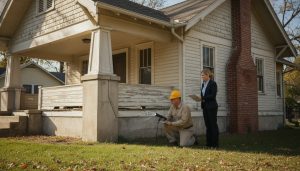Are there risks in older homes I should know
about?
Are older homes hiding expensive problems? Read this first.
Quick answer
Older homes can be gems. They can also hide costly safety and structural risks. Know what to look for, how much it might cost, and how to use a home inspection to force repairs or price concessions.
Common risks in older homes
- Structural issues: sagging floors, cracked foundations, and shifting chimneys. These problems often show slowly and cost thousands to repair.
- Electrical hazards: knob-and-tube wiring, outdated panels, and overloaded circuits increase fire risk. Upgrading can be $3,000–$15,000 depending on scope.
- Plumbing failures: galvanized pipes corrode, lead service lines exist in older systems, and cast-iron drains can fail. Re-piping is expensive and disruptive.
- Hazardous materials: lead paint and asbestos are common in homes built before the late 1970s–1980s. They require licensed abatement when disturbed.
- HVAC and insulation: original furnaces, old boilers, and poor insulation raise energy bills and create cold spots.
- Water intrusion and mold: older roofs, flashing, and gutters fail first. Mold grows where water sits and triggers health issues.
Why these risks matter now
These defects affect safety, resale, mortgage approval, insurance costs, and living comfort. Lenders sometimes require repairs for major structural or safety issues. Insurers may deny coverage or add high premiums when risks exist.

Real examples
- A 1920s bungalow with hairline foundation cracks later required underpinning costing over $20,000.
- A 1960s home with aluminum wiring needed a full rewire after an inspector flagged arcing connections.
Actionable steps to protect your purchase
- Hire a licensed home inspector experienced with older properties. Ask for references and sample reports. Get a report that separates safety issues from cosmetic items.
- Request specialized tests when indicated: asbestos sampling, lead paint testing, sewer camera inspections, and thermal imaging for hidden moisture.
- Use a home inspection contingency in your offer. Negotiate repairs, a price reduction, or a credit to close the deal with a realistic repair allowance.
- Budget for repairs and maintenance. For older homes, set aside a reserve equal to at least 1–3% of the home’s value annually; larger reserves for known issues.
- Get contractor estimates before finalizing the purchase. Replace guesses with real quotes.
Why a local expert matters
Local market knowledge speeds inspections, spots common regional failures, and gives accurate cost estimates. A realtor who understands inspection reports prevents surprises and negotiates repairs effectively.
If you’re shopping older homes and want expert guidance, I can connect you with experienced inspectors and contractors. I help buyers in the Greater Toronto Area avoid hidden costs and close with confidence.
Contact: Tony Sousa, Local Realtor — tony@sousasells.ca | 416-477-2620 | https://www.sousasells.ca
Need an inspector recommendation or a pre-offer review? Call or email now. Clear risks. Clear decisions.





















